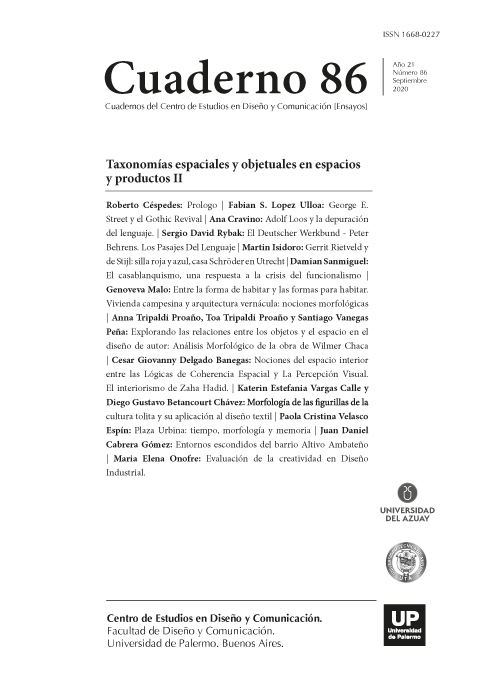Entre la forma de habitar y las formas para habitar. Vivienda campesina y arquitectura vernácula: nociones morfológicas
Abstract
Abstract: This paper proposes an analysis of the referents and conditions that constitute popular peasant housing in the Ecuadorian provinces of Azuay and Cañar, as an expression and form of vernacular architecture. The study begins by problematizing the system of rural living. Spatial configurations are described and analyzed in the framework of a conceptual scheme that takes context as a node to articulate meaning and analysis, based on reflections by Jorge Pokropek (2020), who raises the relationship between social practices and spatial configurations. This relationship carries meaning and identity to define logics of coherence as a mechanism of interpretation and production of interior design. It also brings the notion of form proposed by Dora Giordano (2018) as a cultural product, and Joseph María Montaner who proposes to understand the form as a structure, beyond the geometric configuration. The reflections and analysis on the subject that is exposed are based on data obtained in a research carried out between the University of Cuenca and the University of Azuay in 2016. The data consists of data itself and drawings by hand -pen nibs and observation cards- of the vernacular architecture between 1977 and 1978 in the provinces of Azuay and Cañar.
References
Doberti, R. (2012). De la descripción de las costumbres a la teoría del habitar. Buenos Aires: Ediciones FADU-UBA.
Doberti, R. (2008). Espacialidades. Buenos Aires: Ediciones Infinito.
Giordano, D. (2018). Cuestiones de Diseño, equilibrios inestables sobre campos imprecisos. Buenos Aires: Edición diseño editorial.
ICOMOS. (1999). Carta del Patrimonio Vernáculo Construido. Recuperado el Noviembre de 2018, de http://www.icomos.org/charters/vernacular_sp.pdf.
Malo, G. (2012). Vivienda Popular. Universidad Verdad , 179-194.
Montaner, J. M. (2002). Las formas del siglo XX. Barcelona: Gustavo Gili. Muñoz Vega, P. (2015). Arquitectura popular en Azuay y Cañar. Cuenca: Univerisidad de Cuenca - CIDAP.
Pokropek, J. (2020). Lógicas de coherencia para la interpretación y produccón del diseño interior y sus criterios de selección de formas objetuales. Cuaderno (81), 19-29.
Rappoport, A. (1969). Vivienda y Cultura. Barcelona: Gustavo Gili.
Tamayo, J., & otros, y. (2017). Arquitectura Vernácula en Azuay y Cañar. Cuenca: en prensa. Tamayo, J., Malo, G., & García, G. (aprobada para publicación 2019). El dibujo y su aporte a la identificación de valores de la Arquitectura Vernácula. ESTOA .
Zorrila, H. (2015). El concepto de Arquitectura Vernácula. Recuperado en diciembre de 2018, de http://arquiecturadecasas.info/el-concepto-aquitectura-vernácula/.
Los autores/as que publiquen en esta revista ceden los derechos de autor y de publicación a "Cuadernos del Centro de Estudios de Diseño y Comunicación", Aceptando el registro de su trabajo bajo una licencia de atribución de Creative Commons, que permite a terceros utilizar lo publicado siempre que de el crédito pertinente a los autores y a esta revista.


